Texas rare high sun halos - OPOD
Texas Rare High Sun Halos - An Extraordinary Atmospheric Phenomenon
Have you ever witnessed a rare atmospheric optical display? On May 29, 2014, in Laredo, Texas, photographers Araceli Cadena and Lizett Montiel captured stunning images of rare high sun halos. These incredible photographs were brought to the attention of OPOD (Optics Picture of the Day) by Richard Berler, the Chief Meteorologist at KGNS TV. The images depict a variety of halo formations, including circular halos, parhelic circles, infralateral arcs, and more. Let's delve into the intricacies of these remarkable atmospheric phenomena and explore the possible explanations behind them.
Unraveling the Mystery of Halos
Halos are optical phenomena that occur when light interacts with ice crystals in the atmosphere. They often manifest as luminous rings or arcs around the sun or moon. While halos are relatively common, the particular high sun halos observed in Laredo, Texas, on May 29, 2014, were exceptionally rare. Let's take a closer look at the different halo formations captured in the photographs:
-
Circular Halo: The images showcase a bright circular halo surrounding the high sun. This halo is created by horizontal hexagonal ice crystals. The reflection of light from the end faces of these column-shaped crystals generates the circular halo.
-
Parhelic Circle: A smaller and fainter circle passes through the sun and extends just beyond the bright halo. This phenomenon is known as a high sun parhelic circle. It differs from its usual appearance near the horizon when the sun is low.
-
Halo X: An arc touches the circular halo and extends beyond it at the top. This peculiar and very rare formation is referred to as Halo X.
-
Infralateral Arc: Positioned below the sun, an infralateral arc can be observed. It appears as a faint arc and is created by rays of light entering an end face of the ice crystals and exiting through a lower side face.
-
Halo Y: Located slightly above the large and colorful arc below the sun, Halo Y accompanies the infralateral arc. The enhanced views of the photographs clearly depict Halo Y.
Decoding the Halo Formations
The captivating halo formations observed in Laredo, Texas, raise intriguing questions about their origins and mechanisms. To understand these phenomena, researchers have employed ray tracing simulations and crystal orientation analyses. Let's explore some of the proposed explanations:
-
Horizontal Hexagonal Columns: The circular halo and parhelic circle can be attributed to the presence of horizontal hexagonal column-shaped ice crystals. These crystals generate the circumscribed halo around the high sun. Reflections from the end faces of these crystals produce the parhelic circle.
-
Parry-Oriented Columns: The appearance of Halo X suggests the involvement of Parry-oriented column-shaped ice crystals. The rays forming this halo enter an upward-facing prism side and exit through the lower horizontal face. This path, known as path 4,6 lower Parry arc, corresponds to specific face numbers.
-
Singly Oriented Columns: Infralateral arcs are formed when rays of light enter an end face of singly oriented column-shaped ice crystals and exit through a lower side face.
-
Randomly Oriented Crystals: The presence of randomly oriented ice crystals contributes to the formation of a 22° halo, which is nearly indistinguishable from the circumscribed halo at high sun angles. Additionally, these crystals give rise to a weak 46° circular halo, whose distance above the infralateral arc depends on the sun's altitude.
-
Plate Crystals: Plate crystals may also play a role in the observed halo formations. Their rotational positions about a horizontal "Lowitz" axis could generate Lowitz halos. However, the weak infralateral arc compared to the images suggests that plate crystals alone might not fully account for the display.
Exploring Possible Explanations
While researchers have proposed several explanations for the observed high sun halos in Laredo, Texas, some aspects of the phenomenon remain open to interpretation. Here are two possible explanations:
-
Economy and Exotic: One explanation suggests that the display can be accounted for by a combination of Parry-Lowitz columns, ordinary columns, and plate crystals. This hypothesis offers a more economical explanation, as it involves fewer crystal types. However, the weak infralateral arc relative to the images poses a challenge to this explanation.
-
More Complexity and More Commonplace: Another explanation posits that the display requires a more complex arrangement of crystal types, including horizontal hexagonal columns, Parry-oriented columns, singly oriented columns, randomly oriented crystals, and plate crystals. This hypothesis provides a more comprehensive account of the observed halo formations but adds complexity to the overall explanation.
Witnessing the Extraordinary
The rare high sun halos witnessed in Laredo, Texas, on May 29, 2014, offer a glimpse into the captivating world of atmospheric optics. These optical phenomena, created by the interaction of light with ice crystals, continue to inspire scientists and photographers alike. While researchers strive to unravel the intricacies behind these rare displays, we can marvel at the beauty and complexity of nature's wonders unfolding in the sky above us.
So, keep your eyes to the heavens, for you never know when you might witness an extraordinary atmospheric phenomenon like the rare high sun halos of Laredo, Texas.
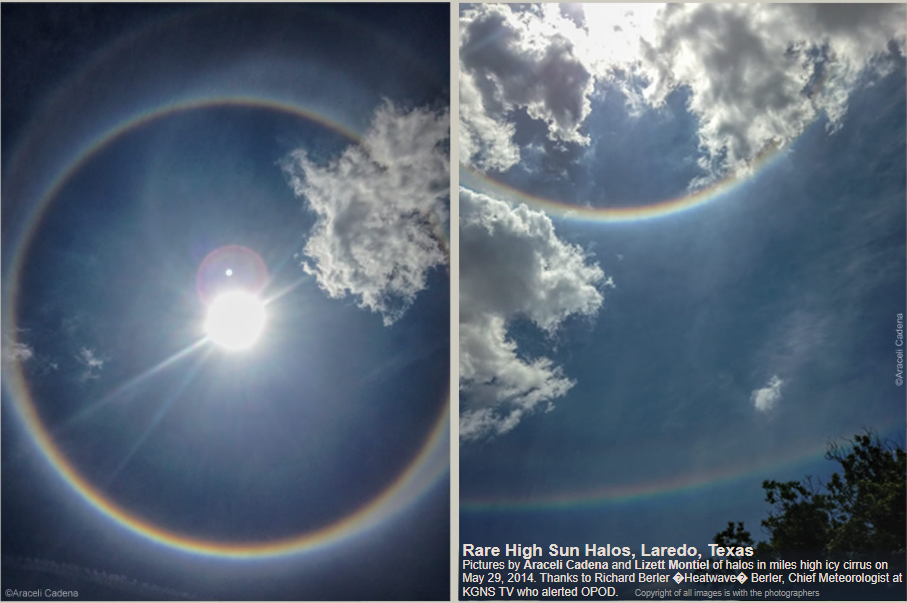
Rare High Sun Halos, Laredo, Texas
Pictures by Araceli Cadena and Lizett Montiel of halos in miles high icy cirrus on May 29, 2014. Thanks to Richard Berler �Heatwave� Berler, Chief Meteorologist at KGNS TV who alerted OPOD. Copyright of all images is with the photographers
At top left the 77� high sun is surrounded by a bright �circular� halo. A smaller and fainter circle passes through the sun and extends just beyond the bright halo. This is undoubtedly a high sun parhelic circle and far different from its usual huge appearance near the horizon when the sun is low.
The arc touching the 'circular' halo and extending out beyond it at top .call it Halo X. is peculiar and very rare..
Below the sun and pictured at top right (80� sun) there is a large and colourful arc. There is a faint arc .Halo Y. slightly above it. The enhanced views at right show it clearly.

Colour subtraction versions of Araceli Cadena's images.
The lower arc measures 27.6° from the inner halo (prediction 28° for infralateral or circumhorizon arc).
At left Halo Y is 4.3° above it. At right (43s later) the separation is 4.7°.
What are the halos?
(1) Let's throw some crystals into HaloSim and attempt to ray trace the display. First of all some horizontal hexagonal columns.
The columns generate the 'circular' halo as a high sun circumscribed halo. Reflections from the column end faces produce a tiny parhelic circle.
Below the sun is a faint infralateral arc. Ray tracing could make it more intense by shortening the column crystals. However, that would brighten the parhelic circle too much and give a brighter Wegener arc that is not seen in the photographs.
Halo X is not from horizontal column crystals. Could it be a high sun Parry crystal arc?
(2) Add some Parry oriented columns to the mix and Halo X appears. Rays forming it enter an upward facing prism side and leave through the lower horizontal face (path 4,6 lower Parry arc - see face number scheme).
Problem! A second Parry arc appears in the ray tracing that is not in the photographs. Its rays pass through the same faces but reflect internally from face 5 (path 4,5,6). This is a high sun version of a helic arc.
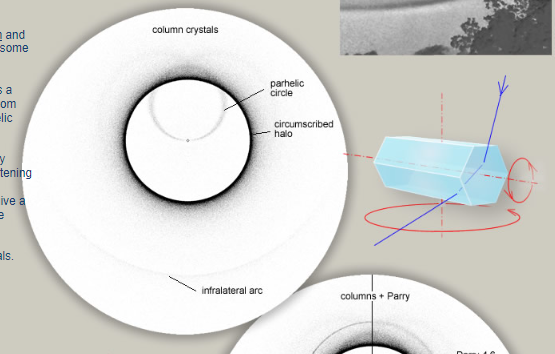
"Singly oriented columns" drift with their long axes nearly horizontal. They take up all rotational positions about the axis.
An infralateral arc forms from rays entering an end face and leaving through a lower side face.

Parry oriented crystals have their long axes horizontal and their upper and lower side faces also horizontal. 4,5,6 is a helic arc from the Parry crystals.
(3) We can blur out the unwanted arc by tuning the Parry crystals. The right hand simulation has Parry crystals with an increased wobble (standard deviation 1° instead of the 0.3° in the left hand ray tracing). The main Parry arc is now also less unnaturally sharp and more like that in the images.
Some halo ray paths are more sensitive than others to small crystal misalignments.
(4) Arc Y just above the infralateral arc remains unsimulated.
Add some randomly oriented crystals.
They produce a 22° halo but at this high sun it is almost indistinguishable from the circumscribed halo.
More interestingly, a weak 46° circular halo appears.
Its distance above the infralateral arc is very sensitive to the sun's altitude. At an 80° high sun it is 3.8° which compares to the 4.3-4.7° estimated from the images.


(5) A remaining issue is the weakness of the infralateral arc. Perhaps some plate crystals were also in the Texan skies to produce a circumhorizon arc? Below the sun the infralateral and circumhorizon arcs overlap.
At left we have ray tracings from a mixture of (a) columns, (b) Parry columns, (c) randomly oriented crystals and (d) plates.
The ray tracing reproduces the features of this rare display.
Is this the only explanation?
(6) The existence of Lowitz arcs was until comparatively recently hotly debated. Now cameras capture them many times each year.
Lowitz halos were traditionally explained by plate crystals taking all rotational positions about a horizontal �Lowitz� axis. Now, with more sightings, many displays are somewhat better accounted for by allowing Parry crystals to rock or nod from horizontal in 'Parry-Lowitz' mode.
At right the ray tracing uses only Parry-Lowitz columns, ordinary columns and some plate crystals. The Lowitz crystals generate both halos X and Y (the latter is a 46° Lowitz arc). But for the possible problem of the weak infralateral arc compared to images, the plates could be tossed away leaving only two types of crystals to account for the display, we might even relax the restrictions on the Lowitz orientations.
A more economical explanation and hard to distinguish from (5).
The choice is yours! Economy and exotic or more complexity and more commonplace.
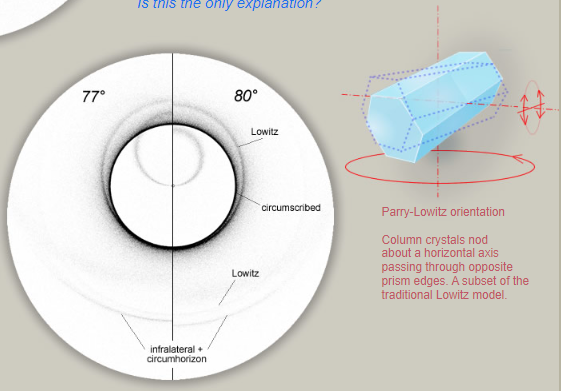
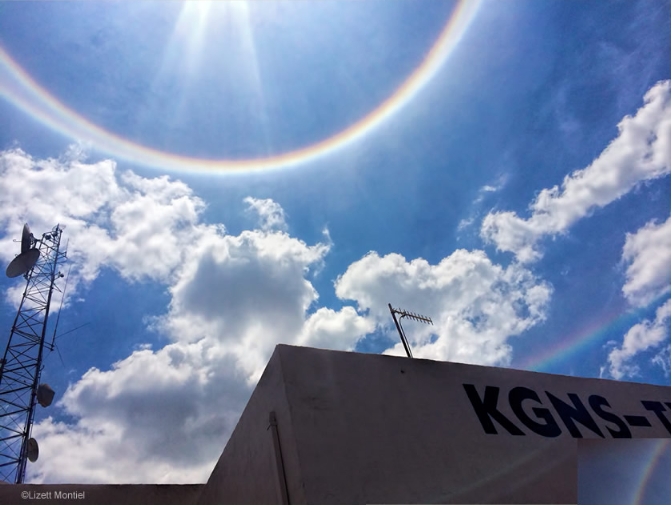
Images at KGNS-TV by Lizett Montiel.
The outer arc (Parry or Parry-Lowitz) is immensely bright. A faint parhelic circle passes through the sun. Near the building we see the infralateral arc with widely spread colours.
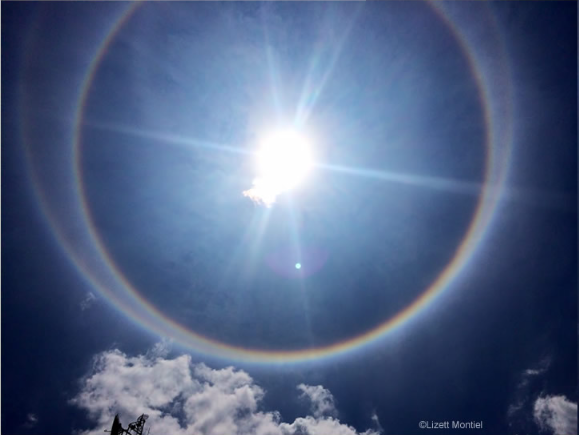








Note: this article has been automatically converted from the old site and may not appear as intended. You can find the original article here.
Reference Atmospheric Optics
If you use any of the definitions, information, or data presented on Atmospheric Optics, please copy the link or reference below to properly credit us as the reference source. Thank you!
-
<a href="https://atoptics.co.uk/blog/texas-rare-high-sun-halos-opod/">Texas rare high sun halos - OPOD</a>
-
"Texas rare high sun halos - OPOD". Atmospheric Optics. Accessed on November 24, 2024. https://atoptics.co.uk/blog/texas-rare-high-sun-halos-opod/.
-
"Texas rare high sun halos - OPOD". Atmospheric Optics, https://atoptics.co.uk/blog/texas-rare-high-sun-halos-opod/. Accessed 24 November, 2024
-
Texas rare high sun halos - OPOD. Atmospheric Optics. Retrieved from https://atoptics.co.uk/blog/texas-rare-high-sun-halos-opod/.